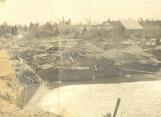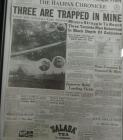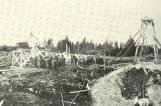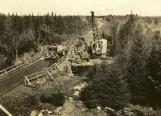1
When the last shift left the mine on April 12, 1936 Suther Higgins was handling the lift.Within minutes Scadding, McGill and Robertson entered the Meyers shaft. At the 43 meter, or 141 foot level the poles holding up the shaft started to crumble and the earth caved in. Suther heard the rock falling and the bell signal from the men asking for a lift up. There was a deafening roar and then silence. Within the hour miners above ground tried to reach the men.
Below ground the three men knew they had about 20 hours of light and they had to choose some place relatively safe to stay during that time before their world became totally black. They built a fire using a dynamite box for fuel and using the lantern as a lighting source since their matches were soaked.
Miners from near by Caribou Gold Mines arrived to aid the Moose River miners in their rescue attempts. First they tried the abondoned Archibald Shaft and when that didn't work they tried several smaller shafts but to no avail.
As they laboured through the night the trapped men were loosing strength in the cold damp underground. Magill and Robertson both became physically ill; Robertson being a Doctor realized the importance of staying awake and moving and kept encouraging the other two to drink water from a near by pipe and to move frequently.
As morning dawned with no success Mrs. McGill was told of the cave in. Not wanting to alarm her daughter she boarded the morning train to Halifax without contacting anyone. Mrs. Scadding was also informed but couldn't come because her mother and daughter were both ill.
Constables Campbell and Wilson were sent from the Sheet Harbour RCMP to help and to try and keep order. Reporters from the Halifax paper were arriving by this time to a scene of chaos and despair that the three might not be rescued on time.
A mines inspector noticing the wisps of smoke felt that there might be a fire in the mine. Henderson, who had come to the site despite his illness, was convinced that the men were alive and were trying to signal those on the surface.
The nearby Meagher shaft was being used at this time when suddenly it caved in nearly trapping the rescuers.
By this time so many people were converging on the community that people were sleeping on floors, in sheds, anywhere they could lay down and every homemaker was pressed into service to provide food. Weather was against the rescurers and those trying to get to the community; it was later noted that "winter continued until summer with no spring in between" with rain and cold sleet everyday. McGill's dog Moose was kept inside all day so they didn't have to listen to his whimpering for his master.
By noon of the second day crews of 40 were working under the direction of J. P. Messerney from the Mines office. In the mine, things were getting worse as they tried to heat rocks to hold close to their cold bodies. Scadding's feet were the first to go numb; a situation which worried Dr. Robertson greatly. McGill with his knowledge of mining was beginning to worry about the water rising and drowning them.
Horton and Company from Halifax arranged for a Delco light plant donated by Canadian Fairbanks Morse to be delivered to Moose River to aid the rescue efforts.
Billy Bell of Springhill heard news of the disaster and contacted the Dept. of Mines for permission to take a diamond drill to Moose River and aid in the rescue effort. He had been a diamond driller for the Department for 20 years and had been trapped in mines on two occasions himself. His request was refused and he returned to work near New Glasgow for his regular shift.
There were no accurate diagrams of the shafts in the area and this was causing problems for the men on site. They attempted to contact Harvey Higgins from Massachusetts who had a lot of knowledge of the local mines with the plan that he could be flown to Nova Scotia. Hope was fading although Henderson still insisted the men could be alive.
Arrangements were made to ship a crane via rail to Upper Musquodoboit. The Department of Highways had to add supports to bridges and try to add gravel to roads, that were by this time a soupy mess, in order to get the crane from the rail station to the rescue site. Miners from as far away as Ontario were arriving in the tiny community and adding to the numbers requiring food and shelter when not actually working a shift in what was now known as the Death Shaft.
That evening Mrs. Scadding and her brother and Mrs. McGill arrived in Halifax and were rushed to Moose River. Moments after they arrived another cave in at the Meagher Shaft almost took the lives of reporters on the surface and workers in the shaft. Pressure on the government finally got permission from officials to bring a diamond drill to the site.
By now the tension was almost unbearable as men argued over methods to use, reporters argued over the use of the 18 available telephones in the area and men were becoming exhausted from their continual rescue efforts.
Mr. Gladium of Waverley arrived and was able to assist with plans and maps of the shafts in the area making it unnecessary to fly Mr. Higgins in from the U.S. Machinery was arriving on the train in Upper Musquodoboit and a workman was severely injured unloading a tractor meant for the rescue site. After this injury an emergency field hospital was set up in Moose River anticipating more problems as the rescue efforts increased.
Billy Bill got word at 4p.m. that his offer had now been accepted to operate the diamond drill and he set out for Moose River. He and his crew arrived at 2 a.m. on Thursday morning but couldn't set up to drill until daylight mainly because there was still too little information on the shafts and their directions. At dawn he set up and by noon started work after talking with the crews on site.
2
At the 141 foot level the earth that supported the shaft started to crumble.1936
Moose River, Nova Scotia

4
Water filled the shaft and made working conditions difficult and even more dangerous.1936
Moose River, Nova Scotia

6
Blasting continued all day and into the night; cold icy rain forced spectators away and the only ones now working were the crew of 150 miners. More workers arrived through the night and vehicles were pushed or pulled through the muck and mire that had once been a road.Below ground things were deteriorating as McGill lapsed in and out of unconsciousness. Robertson diagonised pneumonia but there was nothing they could do but hold McGill to try to keep him warmer. The drill broke through where Bell thought the men should be and he dropped a flare; in their confusion the three trapped men thought it was a fire and tried to put it out. Because there was no response Billy Bell was ordered to cease the rescue effort but he refused. He convinced officials to try dropping a steam whistle throught the 1 1/2 inch bore hole.
Graham Bell invented the telephone when gold mining was at its height in Nova Scotia. The Maritime Telephone and Telegraph Company in an effort to help the rescue efforts, came up with the idea that a telephone line could be dropped through the drill bore. They worked feverishly trying to get equipment small enough to go through the pipe.
All Saturday evening, the steam whistle was blasted on a regular basis until almost everyone accepted that no answer meant that the trapped men were dead. At 12:30 a.m. Sunday, April 19th Billy Bell was still sounding the whistle at regular intervals. Scadding finally realized what it was and started tapping the pipe. He was able to shout and make Billy Bell understand how desperate their situation was.
Mrs. Robertson and Mrs. McGill were brought on site and were able to talk to their husbands. A hose was dropped through the drill bore and soup and candles were lowered to the men.
News spread like wildfire through the media to the outside world. The Toronto Telegram ran 17 stories that day and the Star in Toronto ran 24. Frank Willis of the CRBC asked to go to Moose River but permission was denied.
MT&T renewed their efforts to find a telephone connection that could be made with the men. F. T. Pond, J. A. Bowman, and F. H. Pinforld left for Moose River with a tiny transmitter they had constructed. They also planned to extend the Moose River Telephone Company's line to the mine site. The road was closed but they made arrangements with the RCMP to travel to the community. When they arrived they were met by the Premier of Nova Scotia, Angus L. MacDonald. While they waited for a microphone to arrive from Halifax they set to work on the phone lines from Middle Musquodobit to Moose River.
On Monday April 20th word came from the mine that the shaft was flooding and they estimated they could only stay there safely another 5-10 hours.
7
On the 6th day William 'Billy Bell' reached the 141 foot level with a diamond drill.April, 1936
Moose River, Nova Scotia

9
The new shaft which would eventually prove to be the rescue route.April, 1936
Moose River, Nova Scotia




